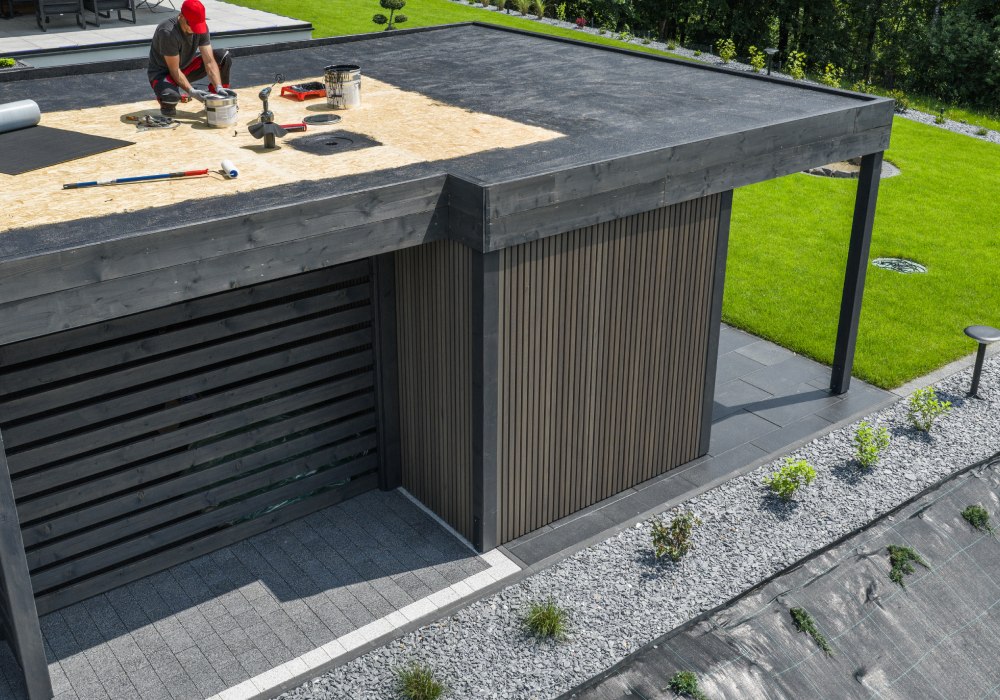- Excellent Customer Service
- Established & Accredited
- Fully Insured & Public Liability
- Highly Rated - 5 Star Reviews
- 24/7 Emergency Call Out
Should I Avoid Buying a House With a Flat Roof?

Flat roofs have a reputation—some earned, some exaggerated. Should you run for the hills or just proceed with eyes open? This guide breaks down the pros, cons, and hidden costs so you can make a savvy, well-roofed decision. Spoiler: flat doesn’t always mean bad—but it does mean different.
Understanding Flat Roof Homes
Unlike pitched roofs, flat roof systems have a near-zero slope, often less than 10°. They’re popular in modern architecture and urban builds. Materials range from EPDM rubber to modified bitumen. But while they look sleek, the design requires precise installation and proactive upkeep to perform well over time.
Typical Issues That Raise Concerns
💧 Water Drainage and the Risk of Leaks
Flat roofs don’t shed water easily. If drainage systems clog or sagging occurs, water pooling leads to leaks, moisture ingress, and long-term structural damage. Waterproof membranes help, but constant vigilance is key.
Structural Wear and Lifespan Limitations
Flat roofing materials generally last 10–25 years—shorter than pitched alternatives. UV exposure, standing water, and poor ventilation can accelerate degradation. Over time, expect repairs to decking, flashing, and seams.
Insulation and Energy Efficiency Challenges
Flat roofs often have less space for thick insulation, causing heat loss in winter and heat gain in summer. Without proper retrofitting or reflective coatings, you might find yourself battling higher energy bills year-round.
How Ownership Affects Your Wallet
Higher Maintenance Needs Over Time
Flat roofs demand regular upkeep—clearing debris, checking seals, and inspecting drainage outlets. Skipping this can fast-track costly damage. Even with modern materials, a flat roof is not a “set it and forget it” situation.
Potential Repair or Replacement Costs
Fixing a flat roof can cost more per square foot than pitched alternatives due to specialized labor and membrane systems. Common repairs include resurfacing, patching punctures, or replacing the vapor barrier. A full replacement? Easily five figures.
What to Budget for Long-Term Upkeep
Set aside 1%–3% of your home’s value annually for roof-related expenses. Include semi-annual inspections, occasional resealing, and emergency fixes. Investing in proactive care now saves you from surprise repair invoices later.
Buying Challenges You Might Face
Why Lenders May Hesitate to Offer Mortgages
Some mortgage providers flag flat-roofed homes as non-standard construction, which can trigger stricter lending criteria, higher deposits, or valuation delays. A full roof survey helps mitigate risk and reassure lenders.
Insurance Limitations or Increased Premiums
Home insurance on flat roofs often comes with higher premiums or limited coverage—especially if over 25% of the roof is flat. Insurers view them as higher risk for leaks and weather damage. Always disclose this upfront.
Legal or Planning Considerations With Extensions
Adding rooftop extensions or alterations? Flat roofs may fall under different planning rules or require structural reinforcement. Check local building codes—especially if installing solar panels, roof gardens, or adding extra height.
Are There Any Benefits?
🌱 Rooftop Use (Green Roofs, Terraces, Solar Panels)
Flat roofs unlock rooftop living—urban gardens, solar panel arrays, even private patios. It’s real estate where space is scarce, and function meets sustainability. Just confirm structural load capacity first.
Contemporary Architectural Style
If you’re into clean lines and modernist vibes, flat-roof homes often deliver. Think minimalist facades, large windows, and Bauhaus-inspired silhouettes that make your property look high-end—even before upgrades.
Easier Access for Inspection and Repairs
Unlike pitched roofs, flat ones offer stable footing. This makes routine checks, minor repairs, or even gutter cleaning less daunting—and potentially cheaper, too. Fewer ladders. Less drama.
Resale and Market Appeal
🧐 How Flat Roofs Are Perceived by Future Buyers
Some buyers hesitate due to perceived risks, especially in older builds. However, if the roof is upgraded and certified, it can flip the narrative—modern, energy-ready, and stylish.
Factors That Can Help Retain or Boost Value
Smart upgrades like high-performance membranes, added insulation, or a usable rooftop space can shift market perception. A home that looks and functions like a premium build wins buyer confidence.
Reducing Buyer Hesitation With Upgrades or Warranties
Offer a transferable roof warranty or provide recent inspection reports. These eliminate unknowns and reduce perceived risk—especially in competitive markets where trust is currency.
Before You Commit: Survey & Inspection Tips
🏚️ Which Type of Property Survey to Request
Don’t settle for a basic valuation—request a Level 3 (Full Building Survey). It digs deeper into structural elements, moisture ingress, and roof decking condition. Flat roofs demand that extra layer of scrutiny.
What a Roofing Specialist Can Spot That Others May Miss
General surveyors aren’t always trained in flat roof pathology. Specialists know how to identify membrane fatigue, flashing failure, and thermal inefficiencies—issues that might otherwise go unseen until it’s too late.
Red Flags vs. Manageable Repairs
Red Flags: consistent ponding, ceiling stains, membrane separation.
Manageable: minor sealant cracks, isolated blistering, clogged drains.
Knowing which is which helps you negotiate repairs or walk away before regrets set in.
Final Verdict: Avoid or Proceed With Caution?
So, should you skip that flat-roofed property? Not necessarily. But go in clear-eyed. It’s less about “avoid” and more about “understand.” Ask: Is the roof modern? Is it well-maintained? Can I handle the upkeep? If yes, you’re not buying a problem—you’re buying potential.
Flat Roof Buyer’s Quick-Check:
✅ Question | 👍 Good Sign | ⚠️ Watch Out For |
|---|---|---|
Roof Age | < 10 years | > 20 years, no updates |
Recent Inspection? | Yes, with documentation | None or outdated |
Drainage + Sealing Condition | Clear, well-sealed | Pooling, cracked membranes |
Insulation & Energy Rating | Good EPC score | Cold spots or high utility bills |
Insurance/Mortgage Friendly? | Approved + reasonable premiums | Limited coverage or higher rates |
Contact Us